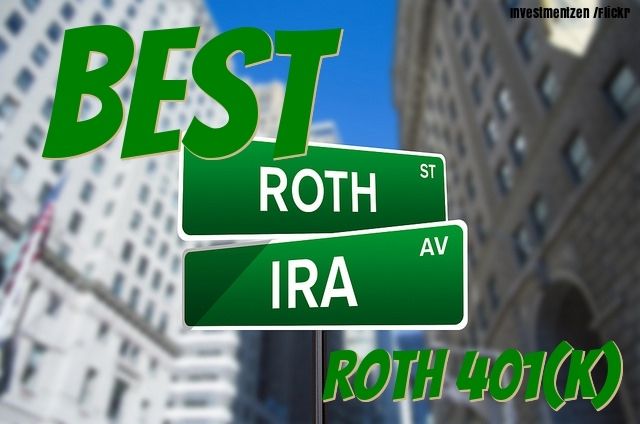Should I be putting more money towards my Roth IRA or Roth 401(k)?

How to pick the Best ROTH IRA. ROTH 401(k) or ROTH IRA?
The good news is more employers are offering a ROTH 401(K) as part of their retirement plans. The bad news is this is giving people more choices, and sometimes too many choices can lead us to do nothing. In reality having more choices and options should make it easier to maximize your retirement planning funds. Which options is right for you ultimately depends on your goals, time frames and perhaps even you retirement plan options.
I will share with you a few questions you should ask yourself to help you make the choice between a ROTH IRA and a ROTH 401(K). Before that I just wanted to cover the basics of a ROTH. You won’t get a tax deduction for making contributions like you would with a traditional IRA or 401(K). On the other hand you won’t have to pay taxes when you make withdrawals from a ROTH account assuming you’ve held the funds for 5 years and are wiser than 59 ½. Lastly, the amount you can contribute phases out when your income reaches $118,000 for singles and $186,000 for married couples.
Now that the basics are out of the way. Assuming you want to have a ROTH as part of your retirement plan, here are a few things to think about when choosing between a ROTH IRA and a ROTH 401(K).
How much can you contribute to the ROTH IRA account?
More importantly how much do you want to save for retirement per calendar year? For a ROTH IRA you can only contribute $5500 per year, whereas the ROTH 401(k) has much higher contribution limits allowing $18,000 per year. These numbers are slightly higher for those 50 or older who are eligible to make catch up contributions. $1000 extra allowed on ROTH IRA’s, and ROTH 401(K) allows an additional $6000 catch up contribution.
In general, the more you want to save the more likely you will lean towards the ROTH 401(K).
Are you eligible for an employer match contribution into your 401(K)?
An employer match is like free money from your boss. Matching contributions will be credited to a regular 401(K) not the ROTH portion, but all the same they still help you move closer to being financial independent. You won’t owe taxes now, but you will be taxed on the employer matching contributions and earnings when you withdraw them. They also need to be kept in the account until you are 59 ½ to avoid IRS penalties.
If you have access to an employer match you should at the very least contribute enough to get the full match to the employer plan. The money is just sitting there for you to claim it. There are no employer matching contributions on regular ROTH IRAs, just in case anyone wanted to know.
The investment options available on your ROTH 401(K)
I know many people don’t always love the investment choices within their 401(K) plans. This is where people often lean towards setting up their own ROTH IRA. If you HATE the investment options in your ROTH 401(K) perhaps fully fund a ROTH IRA at $5500. But still make sure to put enough into your ROTH 401(K) to get the full employer match. If you still want to save more, use the ROTH 401(K) higher contribution limits to keep saving once you’ve maxed out the regular ROTH IRA.
Which option are you more likely to fund appropriately?
Whichever account you are using make sure set up automatic contributions. For a ROTH IRA, put away money monthly on an automatic basis right out of your bank account. For the ROTH 401(K) contributions will be payroll deducted. Which option are you more likely to stick with? This isn’t rocket science, but it is easier to put a little money away each month (or every paycheck) versus coming up with a year of contributions at tax time.
Required Minimum Distributions for ROTH 401(K) and ROTH IRAs-
At some point in the future the wonderful government may force you take to take required minimum distributions (RMDs) once you turn 70.5 years old. These rules do not apply to ROTH IRAs, and this has led many people to mistakenly believe that that same rules apply to ROTH 401(K). Don’t be fooled, required minimum distributions are required from ROTH 401(K) assets. Of course if you are no longer working for an employer you can rollover your ROTH 401(K) to a ROTH IRA (discuss the pros and cons with your fiduciary financial planner) and no longer be forced to take RMDs.
For younger workers this RMD probably won’t change your ultimate decision much. On the other hand if you are closer to retirement this may alter your choice between a ROTH 401(K) and a ROTH IRA. Side note on RMDs for those still working in your 70s- if you are still working for the employer on the 401(K) plan past 70.5 you are not required to take RMDs from that 401(K) plan. This does not apply to outside Traditional IRAs or old 401(K) plans. This rule would also allow you to avoid Required Minimum Distributions from your ROTH 401(K).
Ultimately this choice will boil down you to your preferences and specific financial needs. It may even be a combination of both a ROTH IRA and ROTH 401(K), with a little employer match thrown in. Depending on your income you can potentially have both types of accounts in a year, further increasing your contribution limits. Sit down with a Fiduciary Financial Planner to make sure you are maximizing you retirement savings and staying on track for financial independence.

David Rae David Ono Colleen Sullivan on ABC 7 News sharing financial tips.
Live for Today, Plan for Tomorrow. Until next time and as always Be Fiscally Fabulous.
DAVID RAE, CFP®, AIF® is a Los Angeles-based financial planner with DRM Wealth Management. A regular contributor to Advocate Magazine, Huffington Post, Investopedia not to mention numerous TV appearances. He helps smart people across the USA get on track for their financial goals. For more information visit his website at www.davidraefp.com or the Best Fiduciary Financial Planner blog
The opinions voiced in this article are for general information only. To qualify for the tax free penalty free withdrawal of earnings, a ROTH IRA must be in place for at least 5 tax years, and the distributions must take place after age 59 ½ or due to death or disability. Before taking any specific action, but sure to consult with you tax professional.
You may also enjoy:
